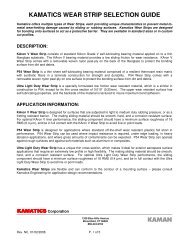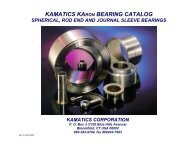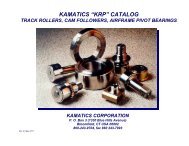Kamatics Karon Design Guide - Kaman Corporation
Kamatics Karon Design Guide - Kaman Corporation
Kamatics Karon Design Guide - Kaman Corporation
Create successful ePaper yourself
Turn your PDF publications into a flip-book with our unique Google optimized e-Paper software.
KAMATICS CORPORATION<br />
View F (Fig 16) depicts a bearing<br />
installed by either a press fit or a slip fit<br />
with a retaining adhesive to assist in<br />
maintaining position. The adhesive<br />
installation is very common with the use<br />
of composite bearings.<br />
VIEW A VIEW B<br />
DOUBLE SIDE<br />
RACE SWAGE<br />
VIEW C<br />
OUTER RACE<br />
THREADED INSERT<br />
SINGLE SIDE<br />
RACE SWAGE<br />
VIEW D<br />
DOUBLE SIDE<br />
HOUSING STAKE<br />
VIEW E VIEW F<br />
SINGLE SIDE<br />
HOUSING STAKE<br />
SNAP RING<br />
RETAINER<br />
Figure 17<br />
(Typical Spherical Bearing<br />
Installation)<br />
Spherical Bearing Installation<br />
There are various methods used to install<br />
spherical bearings. Figure 17 illustrates<br />
some of the more common installations.<br />
When installing a spherical bearing into<br />
its mating housing it is important to<br />
apply the force against the side face of<br />
the outer race and not against the ball.<br />
Pressing on the ball face may tend to<br />
“wedge” the ball into the outer race and<br />
affect the bearing torque. Similarly to<br />
journal bearings, the force to insert<br />
16<br />
KAMAN<br />
should be firm, steady and complete in<br />
one attempt. Use tooling to position the<br />
bearing before insertion if necessary to<br />
insure that the OD enters the housing<br />
properly. On those installations where<br />
the bearing is retained axially, the use of<br />
a small amount of lubricant to aid in the<br />
assembly process is acceptable. This is<br />
assuming it does not interfere with either<br />
the function of the bearing or any sealant<br />
application around the circumference of<br />
the joint after installation.<br />
View A, Figure 17 depicts the more<br />
standard outer race double swaged<br />
groove installation. This method<br />
provides axial retention and allows<br />
multiple bearing replacements without<br />
damaging the housing. Roll or anvil<br />
swaging tools accomplish the swaging or<br />
deforming of the groove into the housing<br />
chamfers. <strong>Kamatics</strong> Tech Note 18 offers<br />
roll swaging information as well as<br />
instructions as to how to manufacture<br />
swaging tools.<br />
View B (Fig 17) depicts another<br />
common installation where one side of<br />
the outer race has a pre-machined lip<br />
that nests into a housing chamfer and a<br />
groove on the opposite side to be swaged<br />
into a housing chamfer. This method<br />
assists in accurately positioning the<br />
bearing in the axial direction and<br />
requires only one swaging operation.<br />
View C (Fig 17) depicts an installation<br />
where the bearing is captured in a<br />
housing by a pre-machined lip on one<br />
side and a removable threaded insert on<br />
the other. The insert is retained within<br />
the bearing via a nylon plug, or similar,<br />
that is deformed into the threads during<br />
assembly. This design is used for those<br />
applications where the bearing may have<br />
to be removed on site where the more<br />
normal swaging is difficult or<br />
impossible.







